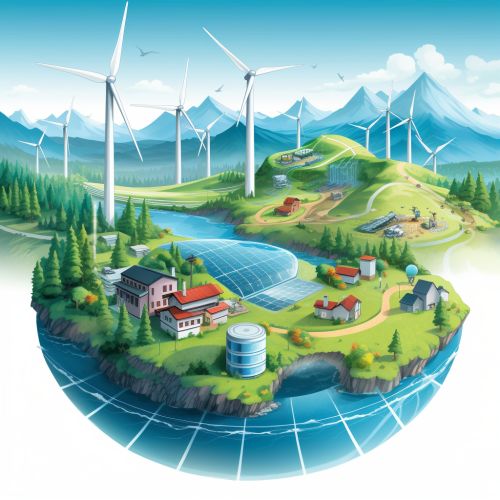Renewable Energy Integration in Smart Grids
Introduction
Renewable energy integration in smart grids is a critical aspect of modern power systems. It involves the incorporation of renewable energy sources, such as solar, wind, hydro, and bioenergy, into the grid infrastructure. This integration is essential for achieving energy sustainability, reducing carbon emissions, and promoting energy security.


Renewable Energy Sources
Renewable energy sources are naturally replenishing energy sources that are environmentally friendly and inexhaustible. They include solar energy, wind energy, hydro energy, bioenergy, and geothermal energy.
Solar Energy
Solar energy is harnessed from the sun's radiation using solar panels. The energy is converted into electricity using photovoltaic cells. Solar energy is a clean, abundant, and sustainable energy source that can be integrated into smart grids.
Wind Energy
Wind energy is generated by converting the kinetic energy of wind into electrical energy using wind turbines. It is a renewable and clean energy source that can be integrated into smart grids, especially in areas with high wind speeds.
Hydro Energy
Hydro energy, or hydropower, is generated by converting the potential energy of water into electrical energy. This is usually done using hydroelectric dams. Hydro energy is a renewable and clean energy source that can be integrated into smart grids.
Bioenergy
Bioenergy is derived from organic materials, such as plant and animal waste. These materials are converted into electricity, heat, or biofuels. Bioenergy is a renewable and sustainable energy source that can be integrated into smart grids.
Geothermal Energy
Geothermal energy is harnessed from the heat within the earth. This heat can be converted into electricity using geothermal power plants. Geothermal energy is a renewable and clean energy source that can be integrated into smart grids.
Smart Grids
A smart grid is an electricity network that uses digital technology to monitor and manage the transport of electricity from all generation sources to meet the varying electricity demands of end users. Smart grids co-ordinate the needs and capabilities of all generators, grid operators, end-users, and electricity market stakeholders to operate all parts of the system as efficiently as possible, minimizing costs and environmental impacts while maximizing system reliability, resilience, and stability.


Integration of Renewable Energy into Smart Grids
The integration of renewable energy into smart grids involves several steps and technologies. It requires the development of advanced grid infrastructure, energy storage systems, and energy management systems.
Advanced Grid Infrastructure
Advanced grid infrastructure is necessary for the integration of renewable energy into smart grids. This includes the development of smart meters, advanced sensors, and communication networks that allow for real-time monitoring and control of the grid.
Energy Storage Systems
Energy storage systems are crucial for the integration of renewable energy into smart grids. These systems store excess energy produced by renewable energy sources and release it when needed. This helps to balance the supply and demand of electricity and ensures grid stability.
Energy Management Systems
Energy management systems are used to control and optimize the generation, distribution, and consumption of electricity in a smart grid. They play a key role in the integration of renewable energy into smart grids by managing the flow of electricity from renewable energy sources to the grid.
Challenges and Solutions
Despite the numerous benefits, the integration of renewable energy into smart grids presents several challenges. These include the intermittent nature of renewable energy sources, grid stability issues, and the need for advanced grid infrastructure. However, these challenges can be addressed through technological advancements, policy interventions, and market mechanisms.
Conclusion
The integration of renewable energy into smart grids is a critical step towards achieving energy sustainability, reducing carbon emissions, and promoting energy security. Despite the challenges, with the right strategies and technologies, it is possible to successfully integrate renewable energy into smart grids and reap the numerous benefits.
